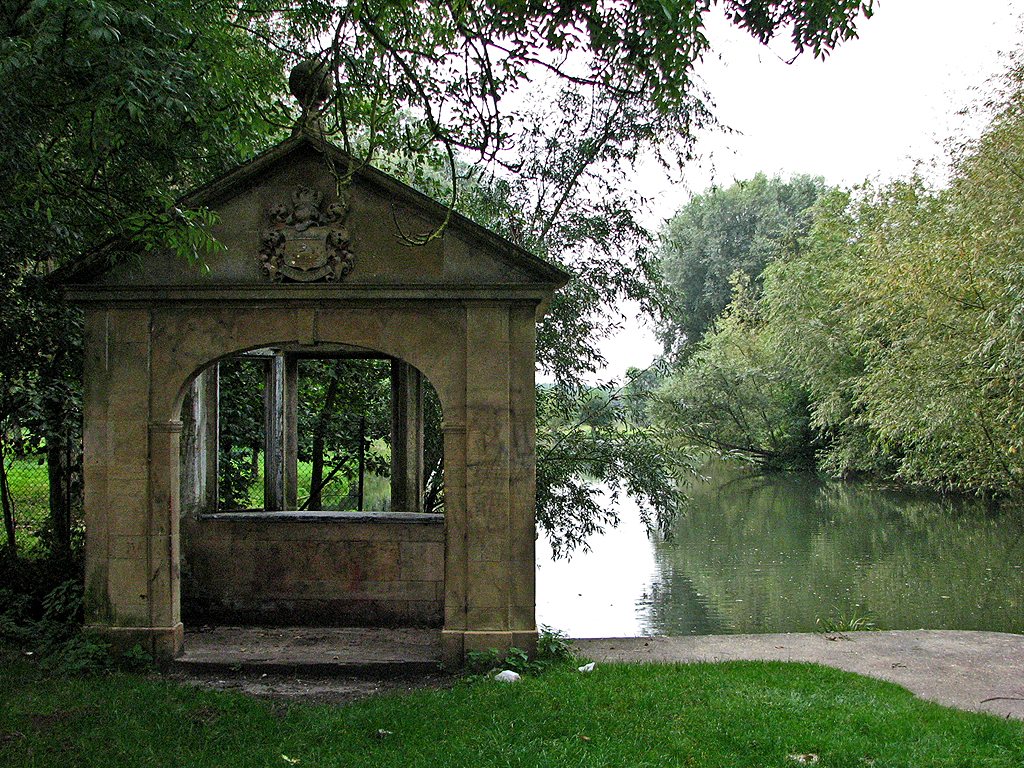Folly

|
| Hodson’s Folly was built in 1887 by John Hodson so that he could keep a watchful eye on his daughters bathing in the river while overseeing his nearby fish hatchery. The land used was common land which Hodson, who was at one point a butler’s assistant at Pembroke College, had annexed without permission. As a speculative builder, Hodson excelled: his building sports a coat of arms, showing a swan in a rain storm, and the summer house and its garden are in many ways a Cambridge college in miniature. (From the University of Cambridge website.) |
In architecture, a folly is typically a costly building that has been constructed for no specific purpose, or for which the original purpose has become obsolete or obscured over time. Its primary function is decorative, although it is sometimes also meant to demonstrate wealth or symbolise virtues.
In some instances, the construction of follies served as a method of employment for those who sought work. They also created projects for artisans who may have been struggling during difficult times.
Follies were often whimsical or eccentric structures that were made to project a false sense of age. For instance, they were made to look like ancient ruins (or sham ruins) despite being relatively modern constructions.
They were frequently constructed as towers, and like eyecatchers, they serve to create a focal point in a landscape, often on the grounds of a stately home. This attracts visual attention or otherwise punctuates the vista with a sense of drama.
Authentic ruins found on estates served as the original model for follies, which were first introduced in the 17th century. They became increasingly popular through the 18th and 19th centuries, adopting more exotic locations and depicting more fanciful eras.
[edit] Related articles on Designing Buildings
Featured articles and news
A change to adoptive architecture
Effects of global weather warming on architectural detailing, material choice and human interaction.
How big is the problem and what can we do to mitigate the effects?
Overheating guidance and tools for building designers
A number of cool guides to help with the heat.
The UK's Modern Industrial Strategy: A 10 year plan
Previous consultation criticism, current key elements and general support with some persisting reservations.
Building Safety Regulator reforms
New roles, new staff and a new fast track service pave the way for a single construction regulator.
Architectural Technologist CPDs and Communications
CIAT CPD… and how you can do it!
Cooling centres and cool spaces
Managing extreme heat in cities by directing the public to places for heat stress relief and water sources.
Winter gardens: A brief history and warm variations
Extending the season with glass in different forms and terms.
Restoring Great Yarmouth's Winter Gardens
Transforming one of the least sustainable constructions imaginable.
Construction Skills Mission Board launch sector drive
Newly formed government and industry collaboration set strategy for recruiting an additional 100,000 construction workers a year.
New Architects Code comes into effect in September 2025
ARB Architects Code of Conduct and Practice available with ongoing consultation regarding guidance.
Welsh Skills Body (Medr) launches ambitious plan
The new skills body brings together funding and regulation of tertiary education and research for the devolved nation.
Paul Gandy FCIOB announced as next CIOB President
Former Tilbury Douglas CEO takes helm.
UK Infrastructure: A 10 Year Strategy. In brief with reactions
With the National Infrastructure and Service Transformation Authority (NISTA).
Ebenezer Howard: inventor of the garden city. Book review.
Airtightness Topic Guide BSRIA TG 27/2025
Explaining the basics of airtightness, what it is, why it's important, when it's required and how it's carried out.





















